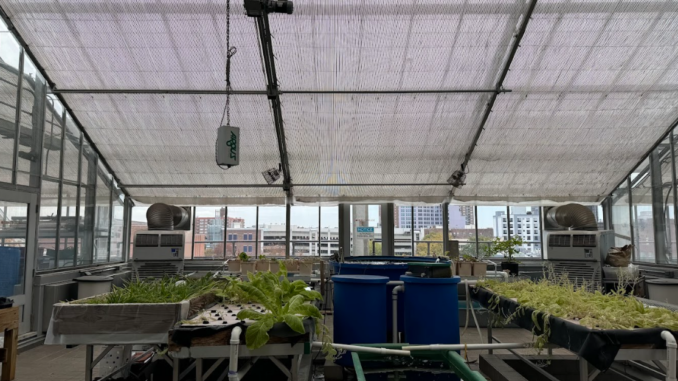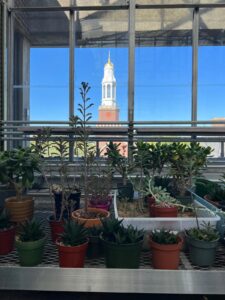
By Danielle Dweck
Located high above the bustling campus, Brooklyn College’s rooftop greenhouse is a hidden gem where sustainability meets science. Perched atop the Ingersoll Hall Extension, the greenhouse serves as a resource for research and education, specifically in the fields of aquaponics and sustainable agriculture. The Vanguard was given an exclusive tour to get full insight into what the greenhouse is achieving.
The Aquatic Research and Environmental Assessment Center (AREAC), the center running the use of the greenhouse, has cultivated tilapia in the basement of the Ingersoll Hall Extension for years, and the completion of the rooftop greenhouse was anticipated to facilitate a comprehensive aquaponics operation, integrating fish farming with plant cultivation.
The greenhouse is currently managed by AREAC lab manager Rob Dickie, whose expertise in integrated recirculating aquaculture, a sustainable aquaculture system that reuses water and nutrients from fish production to grow secondary crops, is used to demonstrate the viability of urban food production. Within the greenhouse, Dickie oversees a recirculating tilapia-vegetable system that serves as an educational tool for various courses and programs at BC. This system exemplifies the concept of a “closed-loop” food production model, where fish and plants are interdependent, creating an ecosystem in which waste is repurposed to benefit plant growth. According to Dickie, the aquaponic system works by raising tilapia which, when fed, give off waste that is used to grow plants.
“We grow the tilapia as our protein source, we feed the fish, they give off waste, that waste gets
run through what’s called a biofilter, and the biofilters break down the harmful ammonia waste product from the fish into a useful product for the plants. That water travels through filters, runs down the plant bed, the plants can uptake the nutrients directly from the water, and the water returns to what’s called a sub. This process is what’s called a recirculating aquaculture system,” Dickie told The Vanguard.

This system supports the growth of a variety of plants and vegetables in the greenhouse, such as lettuce and mustard greens. Beyond supporting plant growth, the system’s efficiency is noteworthy, as it allows for denser plant growth. This dense planting is unlike typical agriculture where plants need room to grow and spread out their roots to uptake nutrients, as the plants in this system are continually soaking in a nutrient-rich solution.
The greenhouse is structured to serve both as a research facility and as an educational resource. It is divided into a central space for general research and four peripheral rooms, each utilized by individual professors for specific research projects.
“We have peripheral rooms in the greenhouse which people utilize for all different types of research. As of now we have Dr. Jennifer Cherrier, Dr. Cheng, and Dr. Muth who run projects out of these spaces. They all come in to do their individual work and research, and use their space for their research and to teach their students,” said Dickie.
This setup allows students to observe or participate in a variety of experiments, gaining first-hand exposure to different methods of sustainable agriculture. Additionally, the greenhouse is used for academic classes, including aquaculture, which is the practice of farming aquatic organisms (such as fish, shellfish and plants) in controlled environments, and aquaponics, a system that combines aquaculture and hydroponics (growing plants in water).
The Science and Technology Entry Program (STEP), designed to support historically underrepresented and economically disadvantaged students pursuing careers in science, technology, engineering, mathematics, and health-related fields, also utilizes the greenhouse. Over the summer, STEP ran a three-week aquaponics course in the greenhouse, where they were taught how to build their own aquaponic systems. The students played a key role in constructing the complex aquaponic system that remains in the greenhouse today, leaving a lasting mark on the facility.
“The greenhouse is a research greenhouse, but is also used for education. We run classes out of here and what you see here in the greenhouse is the remnants of a class I ran in the summertime for the STEP program. We had them build their own aquaponics systems; I taught them how to build the system, how to work with the plants, how to work with the fish, how to test water quality, all education research,” said Dickie.
However, there are many factors and challenges involved with maintenance and upkeep of the greenhouse.
“There are challenges with the science of the greenhouse, and the systems that we run. There are always variables that we can’t control. Temperature plays a role, sunlight sometimes doesn’t cooperate and once it gets cool the room temperature changes. The challenges are with aspects like that, which we adjust to,” Dickie said.
Nevertheless, there are many benefits of the greenhouse, including controlled conditions for plant growth and the opportunity for students to gain hands-on experience in relation to aquaculture systems and the way they run. Suresh Sethi, director of AREAC, described the greenhouse as an engaging and exciting facility that has multiple benefits for the BC students and the surrounding community.
“The greenhouse supports research, education, and outreach, bringing in community groups and other prospective students wanting to learn more about aquatic ecosystems,” Sethi told The Vanguard. “It is exciting to be able to support research from Brooklyn College, supporting both basic research, evolution and biology, and aquatic ecosystems tackling the sustainability problem.”
According to Dickie, there are plans to expand the greenhouse’s role in BC’s curriculum. Future aquaculture classes are being developed for undergraduate students in the greenhouse through the Earth and Environmental Science Department. These classes will introduce students to the complexities of aquaculture, and will include hands-on labs within the greenhouse allowing students to apply classroom knowledge in a fully operational aquaponics system.
Students interested in learning more about the greenhouse can visit www.brooklyn.edu/areac/
